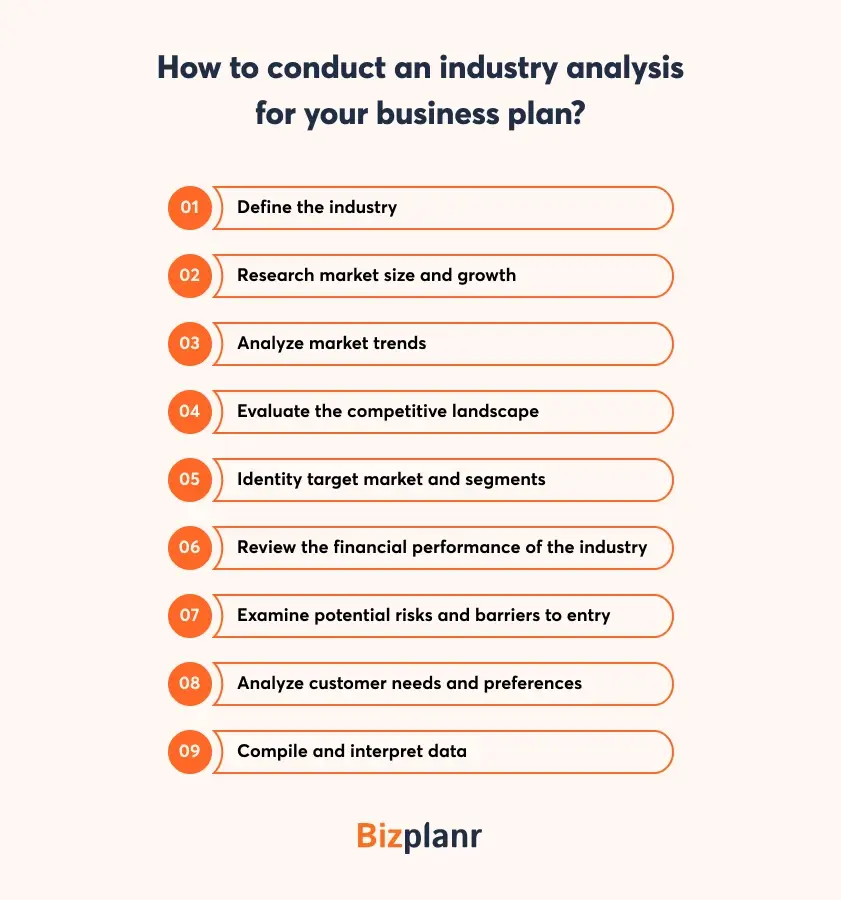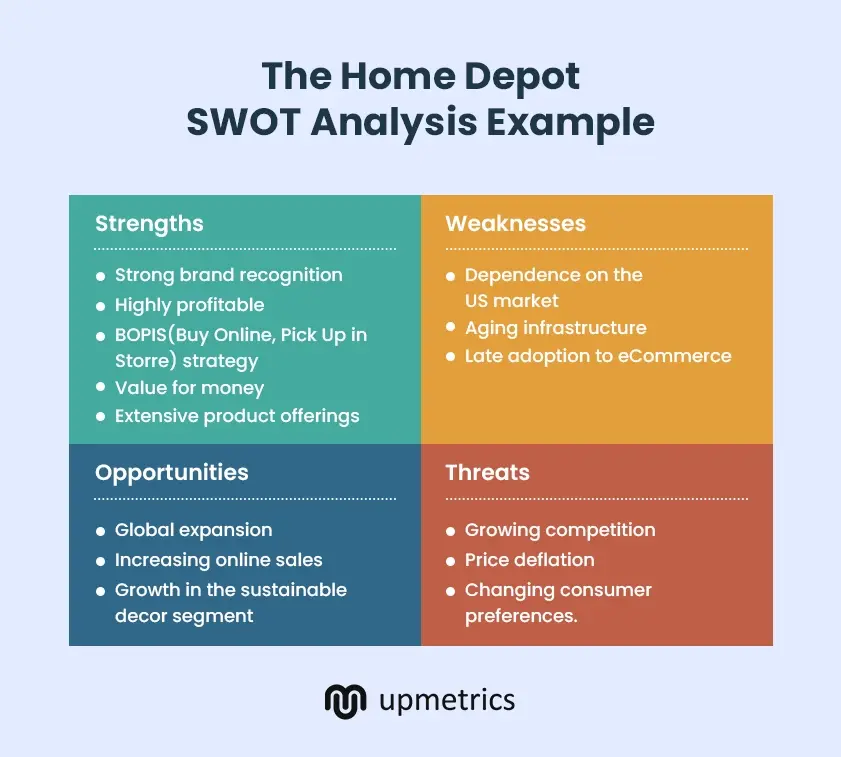- Business Planning

How to Write an Industry Analysis Section in Business Plan

Written by Vinay Kevadiya
Published Oct. 4 2024 · 8 Min Read
Industry analysis in a business plan isn’t just an option; it’s a key driver that steers your business toward success.
To include industry analysis in your business plan requires proper understanding which helps you transform an opportunity into a strategic advantage.
Hence in this blog, you’ll discover everything you need to know about industry analysis in a business plan and how to apply it to drive your business toward success.
Let’s dive in.
What is industry analysis in a business plan?
Industry analysis is a broader examination and evaluation of the market environment in which a business operates. It involves:
- Identifying key players
- analyzing external factors
- Researching marketing trends
- Understanding the competitive landscape
Industry analysis in business planning aims to use potential data and transform it into impactful insights that guide decision-making.
This process ensures that business decisions are not based on guesswork but on solid, data-driven evidence. The valuable insights through industry analysis helps businesses in:
- Identifying gaps
- Providing organic growth
- Highlighting potential risk
- Recognizing market opportunities
Importance of industry analysis in a business plan
Industry analysis provides essential insights that shape a company’s strategic direction. Additionally, it offers numerous other reasons that highlight its importance in a business plan, including the following:
Provides market understanding
Industry analysis provides a comprehensive understanding of the market landscape, including target market, size, growth rate, and current market trends.
Having in-depth market knowledge allows your business to tailor offerings and take advantage of opportunities that can give your business a competitive edge.
Evaluates competitive landscape
Your business must understand competitors' strengths, weaknesses, and market share to stay ahead. A competitive analysis helps position your business more effectively by providing these insights.
By evaluating the competitive landscape, your business will benefit from the following:
- Potential threats
- Strategic advantages
- Market opportunities
- Competitive positions
Offers customer insights
Understanding customer segments and preferences is crucial for tailoring products or services to meet market demands.
Industry analysis provides insights into customer behavior, which enables your business to align its offerings with consumer needs.
Moreover, with insights into customers, it provides market analysis that makes decision-making and keeps your business ahead of your competitors.
Further, if you want to delve deeper into market analysis in a business plan, check out our blog on writing market analysis for a business plan .
Identifies opportunities and risks
Industry analysis highlights potential threats, such as new competitors, changes in consumer behavior, or economic downturns. Moreover, it uncovers potential opportunities for innovation and growth.
With these valuable insights, your business gets the following advantages:
- Complete industry overview
- Proactive and ready to mitigate risk
- Quick capitalization on emerging trends
- Relevant information on customer needs and preferences
Delivers regulatory awareness
Every industry has its own business environment and regulatory landscape. Understanding this environment and regulations is crucial for compliance and can help avoid legal pitfalls.
Industry analysis informs your business about relevant laws, standards, and compliance requirements.
This awareness enables you to adapt your strategies accordingly, which ensures smooth operations and minimizes the risk of penalties.
Attracts investors
Investors need to see a comprehensive understanding of the industry to evaluate the potential success of a business.
A thorough industry analysis shows that the business is prepared for market challenges, making it a more attractive investment. Further, a well analyzed financial metrics help your business to:
- Set realistic business goals
- Measure success against industry standards
- Streamline investment decisions
- Mitigate financial risks
- Smoothen financial operations
Types of industrial analysis
How to conduct an industry analysis for your business plan.
Conducting an industry analysis for your business plan involves several key steps to ensure a thorough understanding of the market landscape. Here’s a step-by-step guide:

Step 1: Define the industry
Start by clearly defining the industry in which your business operates. Whether you're a manufacturing company, IT, or any other sector, it's essential to outline the specific nature of your industry.
To define the scope of your industry, use classification systems such as NAICS (North American Industry Classification System) or SIC (Standard Industrial Classification) codes.
These systems accurately define the scope of your analysis and ensure that you focus on the relevant market segment.
Step 2: Research market size and growth
Gather data on the market size and growth rate. Review reports, surveys, and studies from reliable sources such as government databases, trade associations, or market research firms.
Understanding market potential helps you gauge growth opportunities. Moreover, it helps your business with:
- Identifying untapped market opportunities.
- Planning realistic financial projections.
- Aligning resources with market demands.
- Understanding the competitive landscape.
- Forecasting future industry trends and shifts.
Step 3: Analyze market trends
Look for emerging trends that may impact the industry, including technological advancements, shifts in customer behavior, and current tastes of customers within your industry.
Notably, special attention should be paid to innovations and emerging technologies. Understanding current trends in your particular industry helps you identify the following:
- Potential customers
- Target market
- Unique selling proposition
Step 4: Analyze market trends
Crafting such a table streamlines your business analysis and helps you build a unique selling point. Make sure to refer to or craft such a table when shaping your strategy for differentiation.
Step 5: Identity target market and segments
Break down the market into demographics, needs, or behavior segments. Identify the specific groups your business will target. Examine different significant players, the industry’s size, and growth potential.
Such identification will allow you to tailor your products, services, and marketing strategies to meet the needs of specific customer segments.
Step 6: Review the financial performance of the industry
Look into the financial health of the industry. Assess profitability, cost structures, and margins within the sector. Examining financial performance provides insight into the potential for profitability and economic sustainability in the long run.
Here are the key components that you should review for the financial performance of the industry:
- Return on Investment (ROI)
- Cash Flow Trends
- Revenue Growth
- Cost Structures
- Profit Margins
Step 7: Examine potential risks and barriers to entry
Assess potential barriers to entry, competition intensity, and other external threats that may pose risks to your business. Understanding these challenges prepares you for obstacles you may encounter in the industry.
Here are a few obstacles and risks you should be aware of and analyze for the betterment of your business:
- High capital requirements
- Strict regulatory compliance
- Intense competition
- Supply chain disruptions
- Technological advancements
Your business can create strategies to overcome or mitigate potential challenges by evaluating these risks.
Step 8: Analyze customer needs and preferences
Focus on identifying what your customers want and expect from your product or service. Understanding these needs helps you tailor your offerings and strategies to meet market demand effectively.
From small businesses to larger enterprises, this step determines how your products and services will represent in the market and how they will help to solve the customer's challenge.
To analyze your customer needs and preferences, you can use the following platforms and aspects:
- Industry data
- Social media platforms
- Data from industry associations
- Government websites
- Customer survey and feedback
- Online forums and communities
- Consumer trend reports
- Search engine analytics (e.g., Google trends)
Step 9: Compile and interpret data
Organize all the information you've gathered into clear, actionable insights. Look for patterns, opportunities, and threats.
Compiling data properly will provide a well-rounded understanding of the market and allow you to make informed and strategic decision-making.
This blog has covered the definition, types, and significance of industry analysis in a business plan. We hope you will incorporate these insights into your business plan to drive success and effectively achieve your goals.
However, if you're seeking accurate industry analysis for your business plan, consider using our free AI-powered business plan generator .
You can create a comprehensive business plan by answering a few questions within a few minutes. Our platform analyzes various businesses and utilizes AI capabilities to generate a robust plan tailored to your needs.
Check our platform today!
Get Your Business Plan Ready In Minutes
Answer a few questions, and AI will generate a detailed business plan.
Generate your Plan
Frequently Asked Questions
What is an example of industry analysis in a business plan?
An example of industry analysis is a detailed examination of the competitive landscape for a new coffee shop. This includes identifying competitors, assessing market trends, and understanding customer preferences.
What are the five aspects of industry analysis?
The five aspects are market size and growth, competitive landscape, customer needs and preferences, regulatory environment, and financial performance.
What are the key components of industry analysis?
Key components of industry analysis include market definition, competitor analysis, market segmentation, trend identification, and risk assessment.
How can I present industry analysis in my business plan?
Present industry analysis using clear sections, tables, and visuals. Include concise summaries and relevant data to support your findings.
What are some common mistakes to avoid in industry analysis?
Avoid being too broad in focus, relying on outdated information, ignoring customer insights, failing to analyze competitors, and neglecting to assess potential risks.

As the founder and CEO of Upmetrics, Vinay Kevadiya has over 12 years of experience in business planning. He provides valuable insights to help entrepreneurs build and manage successful business plans.
Follow Vinay Kevadiya
Related Articles

What is Business Location Strategy? A Guide

How to Write Pricing Strategy for Your Business Plan

How to Write the Competitive Analysis of a Business Plan
What Is an Industry Size Business Plan?
An industry size business plan is necessary for budgeting and marketing, especially for those who will seek third-party financing. 3 min read updated on September 19, 2022
An industry size business plan is necessary for budgeting and marketing, especially for those who will seek third-party financing. Most venture capitalists want to know the potential size of the market for the businesses they're investing in. Ultimately, the size of the potential market for the products or services your business is offering determines the value of your business, and to most venture capitalists, the larger that market, the better.
TAM, or Total Available Market, refers to the maximum size of the market for a business's offerings, and it may include both people and revenue. SAM, or Served Available Market, refers to the segment of the TAM consisting of people who will be able to use the business's solution. The SAM will be the business's target market.
Market Size Presentation
The section of your business plan pertaining to market size can be presented in any number of ways. One of the easiest ways to do this is with a simple columnar format that outlines the TAM and SAM now and in five years. This will allow the investor to quickly determine the potential size of the market and its growth over the course of your business plan.
While sizing of the market is important, it is only a plan. The market size section of your business plan can only provide an educated guess at how large the available market will be. This is your opportunity to demonstrate your plans for a successful launch and continued growth.
Available Data and Statistics
Market sizing is largely based on trade association data and any other available statistics. Begin with verifiable base data, including government statistics when available. Cross-reference your information with alternative sources whenever possible. Make sure that your findings make sense.
You should also be specific. For example, you wouldn't want to say, "There are millions of properties in the world with pools, and if we take a small percentage of that, our business plan will work." Rather, keep the industry definition very narrow.
Your analysis will differ depending on whether or not you're dealing with a pre-existing market or a new market. If you're dealing with an existing product, there will be industry and market data available to you. If you're dealing with a new product , you may need to conduct market research, consult with potential customers, and go from there.
Determining Your Market Size
Determining your market size will help you make a clear distinction between two categories:
- Addressable market - the total revenue opportunity for your product or service
- Available market - the portion of the addressable market you can realistically compete with
If you don't have a firm grip on your market size, you'll put your business's success at risk, both in these early stages and through its life cycle.
Estimating Your Market Size
Market sizing will allow you to gain a sense of current market trends. It can help you uncover the drivers of demand, since movements or changes in the market tend to continue for a period of time. Furthermore, studying these trends can reveal whether there's another product on the way that could potentially affect your market size.
When estimating market size, the best place to start is to consider the problem you intend to solve and how much value your product or service will have to consumers. This is actually something many entrepreneurs tend to overlook because they become engrossed in the product they've developed and not its benefits to the audience.
To estimate your market size, follow these steps:
- Clearly define the customer you're targeting.
- Estimate how many customers you will be targeting.
- Figure out your penetration rate.
- Calculate both the volume and the value to your potential market size.
- Apply the data.
Determining Your Market Potential
It doesn't matter if you're seeking third-party financing or not. Understanding the potential for your market will help you in the following areas:
- Product development
- Organizational design
- Distribution
- Partnerships
- Employee skills
Beyond this, understanding your market potential will help you address more mundane issues, such as selecting a bank, hiring an account, or seeking legal counsel .
If you need help with your industry size business plan, you can post your legal need on UpCounsel's marketplace. UpCounsel accepts only the top 5 percent of lawyers to its site. Lawyers on UpCounsel come from law schools such as Harvard Law and Yale Law and average 14 years of legal experience, including work with or on behalf of companies like Google, Menlo Ventures, and Airbnb.
Hire the top business lawyers and save up to 60% on legal fees
Content Approved by UpCounsel
- Business Plan for New Company
- IT Company Business Plan
- Creating a Business Plan
- Parts of Business Plan and Definition
- Defining a Business Venture
- How to Make a Business Plan Format
- Business Plan Format: Everything you Need to Know
- Details of a Business Plan
- Purpose of Business Plan Sample: Everything You Need To Know
- Create a Company
- Search Search Please fill out this field.
- Building Your Business
- Becoming an Owner
- Business Plans
How to Write The Industry Section of a Business Plan
Writing a Business Plan: Section 2
Susan Ward wrote about small businesses for The Balance for 18 years. She has run an IT consulting firm and designed and presented courses on how to promote small businesses.
:max_bytes(150000):strip_icc():format(webp)/SusanWardLaptop2crop1-57aa62eb5f9b58974a12bac9.jpg)
Geber86 / Getty Images
When writing a business plan, the Industry section is best organized as two parts: an overview of the industry and a summary of your business's position within the overall industry.
Before writing this section of the business plan, use these questions to focus your research:
- What is the size of your industry?
- What sectors does this industry include?
- Who are the major players in this industry?
- What are the markets and customers for this industry?
- What are the industry's estimated sales this year? Last year? The year before?
- What national and economic trends have affected this industry and how?
- What national and economic trends might affect it in the future and how?
- What is the long-term outlook for this industry?
- What products or services will your business be selling?
- What is your Unique Selling Proposition? (What is it about your business that makes it unique and sets it apart from competitors?)
- What are the barriers to entry in your industry?
- How will you overcome these barriers?
- Who are your competitors?
- What is the market share of your competitors?
- What is your business's competitive advantage (i.e., your market niche or estimated market share)?
- What is your target market?
- How are you protecting your product or process (i.e., patents, copyrights, trademarks, franchise rights that you either hold or plan to acquire)?
Once you have all this information, you'll write this section of the business plan in the form of several short paragraphs. (Remember, each of these paragraphs is a summary, not a detailed point-by-point explanation.) Use appropriate headings for each paragraph.
Finding Information on Your Industry
But where do you find the information that you need for writing the Industry Overview section of your business plan?
United States Research
In the United States, you may want to start your research by reviewing information from the U.S. Census Bureau, Industry Statistics Portal. This site provides data for selected industries separated into categories using the North American Industry Classification System (NAICS). The Bureau of Labor Statistics also offers a large selection of information grouped by NAICS industry.
There are also other sources of information—some free and some paid sources—including IBIS World, Select USA, and the U.S. the Department of Commerce Bureau of Economic Analysis.
Canadian Research
When you're writing a business plan and looking for information on Canadian industries, Industry Canada is your logical first stop. Their Find Statistics by Industry page lets you see key economic indicators for different sectors of the Canadian economy, access industry profiles, and analysis and research small businesses in Canada generally.
Another primary source for industry and economic information that you can easily access online when you're writing a business plan is Statistics Canada. From this homepage you can find a wealth of free statistical information; use this page, to search for Statistics Canada publications back to 1980.
There are also provincial statistics websites where you'll be able to find more economic, social, and demographic statistics relating to your industry and the business environment.
The Canada Business Service Centres located in each province also offer excellent collections of resources online, and telephone and email information services. You'll find a list of links to the Canada Business Service Centre in each province in my Provincial Programs and Services Resources.
The business sections of national newspapers and business magazines will also be helpful; these often carry features on the past and future business trends.
And don't forget your local sources of business information when you're researching your business plans, such as your Economic Development Centre, Chamber of Commerce, or Women's Enterprise Centre, or the business section of the local library.
Doing Business Plan Research
If your business is related to manufacturing when you're writing a business plan begin by determining the NAICS of your particular industry, and the sector and sub-sector if applicable. It will make it easier for you to find statistical information relating to your industry. If your business is a service, begin with Industry Canada's service industry profiles.
Refer to the list of questions earlier in this article on how to write a business plan as a research guide. Whenever you find a piece of information that you want:
- Check its date and determine whether or not the information is current enough to be valid;
- Write down the date and source of the information, as you'll need to cite your information sources in the business plan.
When you're writing a business plan, you want your research information to be as up-to-date as possible. After all, there's no point in starting a business if you don't want it to succeed.

How to Write the Market Analysis Section of a Business Plan
Written by Dave Lavinsky

What is the Market Analysis in a Business Plan?
The market analysis section of your business plan is where you discuss the size of the market in which you’re competing and market trends that might affect your future potential such as economic, political, social and/or technological shifts.
This helps you and readers understand if your market is big enough to support your business’ growth, and whether future conditions will help or hurt your business. For example, stating that your market size is $56 billion, has been growing by 10% for the last 10 years, and that trends are expected to further increase the market size bodes well for your company’s success.
Download our Ultimate Business Plan Template here
What Should a Market Analysis Include?
You’ll want to address these issues in your market analysis:
- Size of Industry – How big is the overall industry?
- Projected Growth Rate of Industry – Is the industry growing or shrinking? How fast?
- Target Market – Who are you targeting with this product or service?
- Competition – How many businesses are currently in the same industry?
Learn how to write the full market analysis below.
How to Write a Market Analysis
Here’s how to write the market analysis section of a business plan.
- Describe each industry that you are competing in or will be targeting.
- Identify direct competition, but don’t forget about indirect competition – this may include companies selling different products to the same potential customer segments.
- Highlight strengths and weaknesses for both direct and indirect competitors, along with how your company stacks up against them based on what makes your company uniquely positioned to succeed.
- Include specific data, statistics, graphs, or charts if possible to make the market analysis more convincing to investors or lenders.
Finish Your Business Plan Today!
Industry overview.
In your industry overview, you will define the market in which you are competing (e.g., restaurant, medical devices, etc.).
You will then detail the sub-segment or niche of that market if applicable (e.g., within restaurants there are fast food restaurants, fine dining, etc.).
Next, you will describe the key characteristics of your industry. For example, discuss how big the market is in terms of units and revenues. Let the reader know if the market is growing or declining (and at what rate), and what key industry trends are facing your market.
Use third-party market research as much as possible to validate the discussion of your industry.
Here is a list of additional items you may analyze for a complete industry overview:
- An overview of the current state of the industry . How big is it, how much does it produce or sell? What are its key differentiators from competitors? What is its target customer base like – demographic information and psychographics? How has the industry performed over time (global, domestic)?
- Analyze the macro-economic factors impacting your industry . This includes items such as economic growth opportunities, inflation, exchange rates, interest rates, labor market trends, and technological improvements. You want to make sure that all of these are trending in a positive direction for you while also being realistic about them. For example, if the economy is in shambles you might want to wait before entering the particular market.
- Analyze the political factors impacting your industry . This is an often-overlooked section of any business plan, but it can be important depending on what type of company you are starting. If you’re in a highly regulated industry (such as medical devices), this is something that you’ll want to include.
- Analyze the social factors impacting your industry . This includes analyzing society’s interest in your product or service, historical trends in buying patterns in your industry, and any effects on the industry due to changes in culture. For example, if there is a growing counter-culture trend against big oil companies you might want to position yourself differently than a company in this industry.
- Analyze the technological factors impacting your industry . This includes analyzing new technologies being developed in software, hardware, or applications that can be used to improve your product or service. It also includes emerging consumer trends and will be highly dependent on your business type. In a technology-related venture, you would analyze how these changes are impacting consumers. For an educational-related venture, you would analyze how these changes are impacting students, teachers, and/or administrators.
For each of these items, you want to provide some detail about them including their current state as well as what external factors have played a role in the recent past. You can also include many other important factors if they apply to your business including demographic trends, legal issues, environmental concerns, and sustainability issues.
When you are done analyzing all of these factors, wrap it up by summing them up in a statement that includes your view on the future of the industry. This should be positive to attract investors, potential customers, and partners.
If you’re having trouble thinking about all of these factors then it might be helpful to first develop a SWOT analysis for your business.
Once you have an understanding of the market, you’ll need to think about how you will position yourself within that potential market.
Picking Your Niche
You want to think about how large your market is for this venture. You also want to consider whether you’d like to pick a niche within the overall industry or launch yourself into the mainstream.
If you have an innovative product it can be easier to enter the mainstream market – but at the same time, you might face some additional competition if there are similar products available.
You can choose to specialize in a niche market where you’ll face less competition – but might be able to sell your services at a higher price point (this could make it easier for you to get potential customers).
Of course, if your product or service is unique then there should be no competition. But, what happens if it isn’t unique? Will you be able to differentiate yourself enough to create a competitive advantage or edge?
If you are planning on entering the mainstream market, think about whether there are different sub-niches within your specific market. For example, within the technology industry, you can choose to specialize in laptops or smartphones or tablets, or other categories. While it will be more difficult to be unique in a mainstream market, you will still be able to focus on one type or category of products.
How Will You Stand Out?
Many companies are able to stand out – whether by offering a product that is unique or by marketing their products in a way that consumers notice. For example, Steve Jobs was able to take a business idea like the iPhone and make it into something that people talked about (while competitors struggled to play catch up).
You want your venture to stand out – whether with an innovative product or service or through marketing strategies. This might include a unique brand, name, or logo. It might also include packaging that stands out from competitors.
Write down how you will achieve this goal of standing out in the marketplace. If it’s a product, then what features do you have that other products don’t? If it’s a service, then what is it about this service that will make people want to use your company rather than your competition?
You also need to think about marketing. How are you going to promote yourself or sell your product or service? You’ll need a marketing plan for this – which might include writing copy, creating an advertisement, setting up a website, and several other activities. This should include a description of each of these strategies.
If you’re struggling with the details of any of these sections, it might be helpful to research what other companies in your market are doing and how they’ve been successful. You can use this business information to inform your own strategies and plans.
Relevant Market Size & Competition
In the second stage of your analysis, you must determine the size and competition in your specific market.
Target Market Section
Your company’s relevant market size is the amount of money it could make each year if it owned a complete market share.
It’s simple.
To begin, estimate how many consumers you expect to be interested in purchasing your products or services each year.
To generate a more precise estimate, enter the monetary amount these potential customers may be ready to spend on your goods or services each year.
The size of your market is the product of these two figures. Calculate this market value here so that your readers can see how big your market opportunity is (particularly if you are seeking debt or equity funding).
You’ll also want to include an analysis of your market conditions. Is this a growing or declining market? How fast is it growing (or declining)? What are the general trends in the market? How has your market shifted over time?
Include all of this information in your own business plan to give your readers a clear understanding of the market landscape you’re competing in.
The Competition
Next, you’ll need to create a comprehensive list of the competitors in your market. This competitive analysis includes:
- Direct Competitors – Companies that offer a similar product or service
- Indirect Competitors – Companies that sell products or services that are complementary to yours but not directly related
To show how large each competitor is, you can use metrics such as revenue, employees, number of locations, etc. If you have limited information about the company on hand then you may want to do some additional research or contact them directly for more information. You should also include their website so readers can learn more if they desire (along with social media profiles).
Once you complete this list, take a step back and try to determine how much market share each competitor has. You can use different methods to do this such as market research, surveys, or conduct focus groups or interviews with target customers.
You should also take into account the barriers to entry that exist in your market. What would it take for a new company to enter the market and start competing with you? This could be anything from capital requirements to licensing and permits.
When you have all of this information, you’ll want to create a table like the one below:
Once you have this data, you can start developing strategies to compete with the other companies which will be used again later to help you develop your marketing strategy and plan.
Writing a Market Analysis Tips
- Include an explanation of how you determined the size of the market and how much share competitors have.
- Include tables like the one above that show competitor size, barriers to entry, etc.
- Decide where you’re going to place this section in your business plan – before or after your SWOT analysis. You can use other sections as well such as your company summary or product/service description. Make sure you consider which information should come first for the reader to make the most sense.
- Brainstorm how you’re going to stand out in this competitive market.
Formatting the Market Analysis Section of Your Business Plan
Now that you understand the different components of the market analysis, let’s take a look at how you should structure this section in your business plan.
Your market analysis should be divided into two sections: the industry overview and market size & competition.
Each section should include detailed information about the topic and supporting evidence to back up your claims.
You’ll also want to make sure that all of your data is up-to-date. Be sure to include the date of the analysis in your business plan so readers know when it was conducted and if there have been any major changes since then.
In addition, you should also provide a short summary of what this section covers at the beginning of each paragraph or page. You can do this by using a title such as “Industry Overview” or another descriptive phrase that is easy to follow.
As with all sections in a business plan, make sure your market analysis is concise and includes only the most relevant information to keep your audience engaged until they reach your conclusion.
A strong market analysis can give your company a competitive edge over other businesses in its industry, which is why it’s essential to include this section in your business plan. By providing detailed information about the market you’re competing in, you can show your readers that you understand the industry and know how to capitalize on current and future trends.
Business Plan Market Analysis Examples
The following are examples of how to write the market analysis section of a business plan:
Business Plan Market Analysis Example #1 – Hosmer Sunglasses, a sunglasses manufacturer based in California
According to the Sunglass Association of America, the retail sales volume of Plano (non-prescription) sunglasses, clip-on sunglasses, and children’s sunglasses (hereinafter collectively referred to as “Sunwear”) totaled $2.9 billion last year. Premium-priced sunglasses are driving the Plano Sunwear market. Plano sunglasses priced at $100 or more accounted for more than 49% of all Sunwear sales among independent retail locations last year.
The Sunglass Association of America has projected that the dollar volume for retail sales of Plano Sunwear will grow 1.7% next year. Plano sunglass vendors are also bullish about sales in this year and beyond as a result of the growth of technology, particularly the growth of laser surgery and e-commerce.
Business Plan Market Analysis Example #2 – Nailed It!, a family-owned restaurant in Omaha, NE
According to the Nebraska Restaurant Association, last year total restaurant sales in Nebraska grew by 4.3%, reaching a record high of $2.8 billion. Sales at full-service restaurants were particularly strong, growing 7% over 2012 figures. This steady increase is being driven by population growth throughout the state. The Average Annual Growth Rate (AGR) since 2009 is 2.89%.
This fast growth has also encouraged the opening of new restaurants, with 3,035 operating statewide as of this year. The restaurant industry employs more than 41,000 workers in Nebraska and contributes nearly $3 billion to the state economy every year.
Nebraska’s population continues to increase – reaching 1.9 million in 2012, a 1.5% growth rate. In addition to population, the state has experienced record low unemployment every year since 2009 – with an average of 4.7% in 2013 and 2014.
Business Plan Market Analysis Example #3 – American Insurance Company (AIC), a chain of insurance agencies in Maine
American Insurance Company (AIC) offers high-quality insurance at low prices through its chain of retail outlets in the state of Maine. Since its inception, AIC has created an extensive network of agents and brokers across the country with expanding online, call center and retail business operations.
AIC is entering a market that will more than double in size over the next 50 years according to some industry forecasts. The insurance industry is enjoying low inflation rates, steady income growth, and improving standards of living for most Americans during what has been a difficult period for much of American business. This makes this a good time to enter the insurance industry as it enjoys higher margins because customers are purchasing more coverage due to increased costs from medical care and higher liability claims.
American Insurance Company provides affordable homeowners, auto, and business insurance through high-quality fulfillment centers across America that have earned a reputation for top-notch customer service.
AIC will face significant competition from both direct and indirect competitors. The indirect competition will come from a variety of businesses, including banks, other insurance companies, and online retailers. The direct competition will come from other well-funded start-ups as well as incumbents in the industry. AIC’s competitive advantages include its low prices, high quality, and excellent customer service.
AIC plans to grow at a rate that is above average for the industry as a whole. The company has identified a market that is expected to grow by more than 100% in the next decade. This growth is due to several factors: the increase in the number of two-income households, the aging population, and the impending retirement of many baby boomers will lead to an increase in the number of people who are purchasing insurance.
AIC projects revenues of $20M in year one, which is equivalent to 100% growth over the previous year. AIC forecasts revenue growth of 40%-60% each year on average for 10 years. After that, revenue growth is expected to slow down significantly due to market saturation.
The following table illustrates these projections:
Competitive Landscape
Direct Competition: P&C Insurance Market Leaders
Indirect Competition: Banks, Other Insurance Companies, Retailers
Market Analysis Conclusion
When writing the market analysis section, it is important to provide specific data and forecasts about the industry that your company operates in. This information can help make your business plan more convincing to potential investors.
If it’s helpful, you should also discuss how your company stacks up against its competitors based on what makes it unique. In addition, you can identify any strengths or weaknesses that your company has compared to its competitors.
Based on this data, provide projections for how much revenue your company expects to generate over the next few years. Providing this information early on in the business plan will help convince investors that you know what you are talking about and your company is well-positioned to succeed.
How to Finish Your Business Plan in 1 Day!
Don’t you wish there was a faster, easier way to finish your business plan?
With Growthink’s Ultimate Business Plan Template you can finish your plan in just 8 hours or less!
Other Resources for Writing Your Business Plan
How to Write a Great Business Plan Executive Summary How to Expertly Write the Company Description in Your Business Plan The Customer Analysis Section of Your Business Plan Completing the Competitive Analysis Section of Your Business Plan The Management Team Section of Your Business Plan Financial Assumptions and Your Business Plan How to Create Financial Projections for Your Business Plan Everything You Need to Know about the Business Plan Appendix Best Business Plan Software Business Plan Conclusion: Summary & Recap
Other Helpful Business Planning Articles & Templates

AI ASSISTANTS
Upmetrics AI Your go-to AI-powered business assistant
AI Writing Assist Write, translate, and refine your text with AI
AI Financial Assist Automated forecasts and AI recommendations
AI Research Assist Your go-to AI-powered research assistant
TOP FEATURES
AI Business Plan Generator Create business plans faster with AI
Financial Forecasting Make accurate financial forecasts faster
INTEGRATIONS
QuickBooks Sync and compare with your QuickBooks data
Strategic Planning Develop actionable strategic plans on-the-go
AI Pitch Deck Generator Use AI to generate your investor deck
Xero Sync and compare with your Xero data
See how easy it is to plan your business with Upmetrics: Take a Tour →
AI-powered business planning software
Very useful business plan software connected to AI. Saved a lot of time, money and energy. Their team is highly skilled and always here to help.
- Julien López
BY USE CASE
Secure Funding, Loans, Grants Create plans that get you funded
Starting & Launching a Business Plan your business for launch and success
Validate Your Business Idea Discover the potential of your business idea
E2 Visa Business Plan Create a business plan to support your E2 - Visa
Business Consultant & Advisors Plan with your team members and clients
Incubators & Accelerators Empowering startups for growth
Business Schools & Educators Simplify business plan education for students
Students & Learners Your e-tutor for business planning
- Sample Plans
Plan Writing & Consulting We create a business plan for you
Business Plan Review Get constructive feedback on your plan
Financial Forecasting We create financial projections for you
WHY UPMETRICS?
Reviews See why customers love Upmetrics
Blogs Latest business planning tips and strategies
Strategic Planning Templates Ready-to-use strategic plan templates
Business Plan Course A step-by-step business planning course
Customer Success Stories Read our customer success stories
Help Center Help & guides to plan your business
Ebooks & Guides A free resource hub on business planning
Business Tools Free business tools to help you grow
How to Write an Industry Analysis in Your Business Plan?

The Market Analysis Kit
- September 12, 2024
- 12 Min Read

You can’t always make the best decisions for your business without understanding how your industry works. You can’t simply enter a shooting competition without understanding how a gun works, right?
That’s why industrial analysis is a really important part of your business plan.
When you nail industrial analysis, you tell investors you’ve done your homework, know your stuff, and are here to last. You also get the opportunity to substantiate any claims of new innovation.
In this article, we will explore what industry analysis is, why it’s important, and how to write it in your business plan.
Let’s begin.
What is industry analysis in a business plan?
Industry analysis is a market assessment methodology that helps businesses and entrepreneurs understand how their company fares against competitors and works within the larger industry it’s a part of.
You can use it to extract essential industry insights like:
- Supply and demand metrics in your industry
- Understand your competitive landscape better
- See industries that are overlapping or affecting your industry
- New opportunities for Innovation and exploration
Why is industry analysis important for a business plan?
Industry analysis is an important part of a business plan since it gives you a clear vision regarding multiple aspects of the field your company is or wants to occupy.
It will help you get insights like:
- The current size and growth rate of your industry
- Key trends and drivers shaping the industry
- The main players, and their strengths and weaknesses
- The market share distribution among key players
- The customer segments within the industry, and their needs and preferences
- The major challenges and barriers to entering the industry
- The regulatory and legal considerations affecting the industry
- How technology impacts your industry, and emerging innovations
- The typical financial metrics and performance benchmarks for the industry
- The potential risks and uncertainties within the industry, and how they should be mitigated
Comprehensive industry analysis helps you internally strategize your next moves in the business and builds accurate expectations for potential investors.
5 Steps to conduct your own industry analysis
Use the following steps to conduct a thorough industry analysis:
1. Conduct industry background research
Start with researching the background of your industry or a specific subsection of it. Decide what key questions you want your analysis to answer, like competitor behavior, market growth, or industry standards.
Go beyond a simple Google search to look for industry associations by making an additional effort of referencing to things like:
- Reports from firms like Gartner, Forrester, and McKinsey that provide in-depth analyses and forecasts
- Nielsen, Statista, and IBISWorld that offer comprehensive market data and industry statistics
- Data from government sources such as the U.S. Census Bureau, Bureau of Economic Analysis (BEA), and Eurostat
- Data from trade associations like the National Retail Federation (NRF) or American Marketing Association (AMA)
- Business news outlet data from Financial Times, Bloomberg, and The Wall Street Journal for current trends
Make a list of your competitors and explore ways to gather research on them.
2. Collect data
Gather relevant industry data to answer key questions about your target market and competitors. Dive into the latest industry analysis reports, both from your company and others, to spot the latest trends in your business environment.
You should also review competitor ads, promotions, product placements, and financial data to learn about their profits and target consumers. Don’t forget to tap into secondary sources like government stats, marketing reports, and journal articles for additional insights.
Here are some data points to focus on:
- Industry participants: Look at the other players in the industry, both small and big, and see what they’re doing, how they’re innovating or gaining investments.
- Distribution patterns: To effectively manage distribution in your industry, assess whether you need to utilize regional distributors, direct sales, or intermediaries, and adapt your strategy to leverage current technologies and distribution models to optimize reach and efficiency.
- Competition and buying patterns: An industry analysis isn’t complete without a clear mention of how customers decide between competitors when making a purchase decision. What are the factors they look at? What makes certain competitors more successful than others? What’s the sweet pricing spot?
3. Analyze the collected data
Next, use an industry analysis model to examine the data you’ve collected on your particular industry. You can choose from one of the following:
Porter’s 5 Forces or Competitive Forces Model
Porter’s model proposes that if you analyze these five forces, you can get an accurate impression of your industry, making further analysis easier:
1. Intensity of industry rivalry
The number of players in an industry and their market shares reflect its competitiveness. For instance, in the smartphone industry, the lack of product differentiation intensifies competition among brands.
2. Threat of potential entrants
This highlights how easily new firms can enter a market. For instance, entry into the electric vehicle industry is difficult due to factors like high R&D costs and regulatory hurdles. Thus, established companies can enjoy prolonged benefits, facing a consistent set of rivals.

3. Bargaining power of suppliers
When the bargaining power of suppliers is high, your suppliers could set higher prices or reduce the quality of what you buy.
For example, if a semiconductor manufacturing company relies on a limited number of chip suppliers, those suppliers hold significant leverage. This can heavily impact smaller tech companies, as it directly affects both the cost and quality of their products.
4. Bargaining power of buyers
The reverse occurs when customers hold the bargaining power. In the retail industry, if a supermarket chain represents a significant portion of sales for multiple suppliers, it can negotiate lower prices, demand higher quality, or secure additional services and discounts.
5. Threat of substitute goods/services
Industries constantly face competition from others producing substitute products. For example, in the beverage industry, soda companies compete with bottled water and energy drink producers. This rivalry limits their ability to charge high prices.
SWOT Analysis
SWOT stands for S trengths, W eaknesses, O pportunities, and T hreats. These parameters are a great way of getting a quick idea about various facets of the industry. You can use this image for reference:

Broad Factor Analysis or PESTEL Analysis
PESTEL stands for political, economic, social, technological, environmental, and legal factors. It’s beneficial when you’re analyzing such external elements that might affect your business.
4. Pen down your analysis
Once you’re done with collecting and analyzing your data, it’s time to pen it down as an industry analysis document.
Remember to highlight the following sections in your draft:
- Introduction: Give an overview of your industry, competitors, and key industry trends.
- Aim: Clearly state the purpose of your analysis and outline the key questions.
- Data: Present the data you gathered with supporting charts and graphs.
- Analysis: Discuss your findings and answer the questions from the aim.
- Future: Highlight the short- and long-term impacts on the company and any potential challenges.
- Summary: Wrap it up with a brief 3-4 line summary
Tip: You should also use the pointers in this article’s next section to present an ideal industrial analysis document. Don’t forget to proofread and edit once you are done.
5. Evaluate your business position
Once you have the document in front of you, thoroughly evaluate your business. Use the analysis section you created to guide the company’s direction in your focus area.
Let’s say you make soft drinks, and you see a notable shift in consumer’s drinking patterns through industry analysis. You see a lot of your competitors are now launching low-sugar alternatives for their global markets, and the consumer demand for healthier beverages is increasing continuously.
You must actively join the bandwagon and present and document all your efforts to launch healthy beverages from your own brand.
If your findings raise more questions, consider running a follow-up analysis to dig deeper into other industry factors.
How to write the industry analysis section of your plan
Here’s a step-by-step approach to writing a meaningful and actionable industry analysis section for your business plan:
Brief overview
This part highlights the key findings of the analysis and quick recommendations. Herein, you can mention the level of your research, whether it’s on a local, regional, provincial, national, and/or global level. You can also briefly highlight the core points that you will be expanding upon in the upcoming sections.
Industry overview
In the industry overview section, include a short description of your industry with the prime products/services and markets. Make sure you document recent developments, news, and innovations.
For instance, if you’re working in the electric vehicle (EV) industry, this section should answer questions like:
- What are the latest technological advancements in battery efficiency?
- How are government policies influencing the adoption of electric vehicles?
- Who are the leading manufacturers, and what market share do they hold?
- What are the current challenges and opportunities in the EV market?
Government regulations
Be sure to mention any recent laws that impact your industry and the licenses or permits you’ll need to operate in your target market. Don’t forget to cover any associated fees or costs that might come into play
Competitor landscape
This section needs to have an analysis of the major players, market dynamics (share and positioning), competitor strategies, future competition, as well as competitive forces and their unique selling proposition.
Your unique position
Describe what sets you apart in the competitive landscape. For instance, if you’re entering the plant-based food industry, you might highlight how your product’s unique blend of ingredients offers superior taste and nutritional value compared to existing options.
Remember to mention the following:
- Industry forecast: Gather economic data and industry forecasts for various time frames, such as 5, 10, and 20 years, and be sure to cite your sources. Also, clarify whether the industry is new and emerging, growing, maturing, or declining.
- Potential risks and limitations: Discuss the factors that could negatively affect your business, along with your short-term and long-term outlook
Spend more time researching, less writing
Make business plans in minutes with AI
Plans starting from $7/month

Tips to write your industry analysis
Two Simple tips you don’t want to miss:
1. Never make it too long
The structure of the industry analysis section of your business plan depends a lot on your intended audiences and the overall plan’s depth. That being said, an ideal industry analysis section usually occupies around 1-2 pages of a 40-50 page business plan.
Any longer would make it hard for a reader to skim through.
2. Use visuals
Include visual aids like charts, graphs, and tables. They help convey relevant information in a streamlined manner. An ideal analysis should have a mix of text and visuals, with visuals accounting for 20-30% of the content.
Business plan industry analysis example
You can’t simply haphazardly present an industry analysis by lugging together all the collected info on a few pages. You need a well-defined structure. So, here’s an example of a simplified industry analysis draft for you to extract inspiration from.
Business Name: Urban Fusion Bistro Location: Brooklyn, New York Type of Business: Boutique Coffee Roastery
Urban Fusion Bistro is a boutique coffee roastery in Brooklyn, New York, aiming to offer a premium coffee experience with artisanal roasting and a modern atmosphere. Our goal is to serve coffee enthusiasts and casual drinkers with high-quality, single-origin coffees and unique blends.
Government Regulations
Operating requires compliance with local health, safety, and business regulations. Key permits include a business license, food service permit, and possibly a retail food permit, with initial costs of around $25,000.
Competitor Landscape
Brooklyn’s coffee market includes chains and independent cafes. While competition exists, the boutique coffee segment is less saturated. Urban Fusion Bistro’s focus on artisanal roasting and premium products offers a competitive edge.
Unique Position
Urban Fusion Bistro will stand out with its artisanal roasting, curated coffee selection, and modern, inviting ambiance. This approach targets both coffee connoisseurs and casual drinkers seeking a unique experience.
Industry Forecast
The coffee industry in Brooklyn is set to grow steadily, with specialty coffee projected to increase by 7% annually over the next decade. Urban Fusion Bistro is positioned to meet the rising demand for high-quality, artisanal coffee.
Potential Risks and Limitations
Risks include economic downturns, increased competition, and fluctuations in coffee prices. Regulatory changes and evolving consumer preferences may also impact operations. Strategic planning and high-quality standards will be crucial for long-term success.
Financial Position
Urban Fusion Bistro expects first-year revenues of $800,000 with a 20% profit margin. Below are the financial projections:
Urban Fusion Bistro is set to thrive in Brooklyn’s growing coffee market with its focus on artisanal roasting and a unique café experience. Our solid financial plan and understanding of market trends position us for success, promising a distinctive coffee experience for Brooklyn’s coffee lovers.
The bottom line
And with that, you’re all set to write your impressive industry analysis section of your comprehensive business plan.
If you’re still a bit hesitant to do all of this on your own or don’t really know where to start, you can always put your trust into a good business plan software like Upmetrics .
Its AI-powered business plan generator will provide you with both step-by-step guidance and AI assistance so you can generate a perfect business plan with the perfect industry analysis section to help you grab the pulse of your industry.
Build your Business Plan Faster
with step-by-step Guidance & AI Assistance.
Frequently Asked Questions
How can i gather data for an industry analysis.
Collect data from industry reports, competitor advertisements, financial data, government statistics, trade associations, and marketing reports. These sources provide a comprehensive view of market trends, competitor strategies, and industry performance.
What is the function of industry analysis in a business plan?
Industry analysis helps you create resilient strategies and showcase the overall opportunities and risks involved in your field by using a nutshelled presentation of the market environment, opportunities, and threats.
What tools can help in conducting an industry analysis?
Models like Porter’s 5 Forces, SWOT analysis, and PESTEL analysis are effective tools for conducting an industry analysis for your own business. If writing plans yourself is challenging, digital tools are available to help automate the process and ensure accuracy.
How do I present industry analysis in my business plan?
Take up 1-2 pages of your business plan to provide a brief overview of core industrial facets like opportunities, risks, competitors, and ROI expectations. Use visuals like charts and graphs to make the information easily digestible and engaging.
About the Author
Upmetrics Team
Upmetrics is the #1 business planning software that helps entrepreneurs and business owners create investment-ready business plans using AI. We regularly share business planning insights on our blog. Check out the Upmetrics blog for such interesting reads. Read more
Get started with Upmetrics Al
- 400+ sample business plans
- Al-powered financial planning
- Collaborative workspace
Reach Your Goals with Accurate Planning
Market Size: The Two Best Methods for Market Sizing Your Business, Plus Expert Tips
Updated: September 20, 2024
Published: April 10, 2019
When considering a new venture, you must understand: “What is market size?” More specifically, you need to know your venture’s potential market size. But “Why?” I hear you ask.

Picture this: You’ve put in months of hard work only to realize that 100 people in the U.S. will potentially buy your product.
The potential revenue from that population size may be worth your product's manufacturing, production, and distribution costs — or it may not.
But even if you’ve got 10,000 potential customers, you still need to go deeper in your market sizing to understand whether there’s a viable market.
Below, I’ll share methods to calculate your market size and accurately measure your business’ revenue potential.
I will also share first-hand experiences from founders, CEOs, entrepreneurs, and more who spoke to me about their market sizing journeys.

Keep reading, or jump to the section you’re looking for:
What is market sizing?
Why is market size important, market size vs. market value, market sizing terms to know, how to calculate market size, market sizing methods, market size: faqs.
Market sizing is the process of finding how big your product's audience or revenue could be. So, market size is the total number of potential buyers for a product or service and the potential revenue reach based on that population size.
When market sizing, you're calculating customer numbers to measure the growth potential of your business.

Free Market Size Calculator
Five calculators to help you quickly and easily calculate your market size
- Total Addressable Market (TAM)
- Serviceable Addressable Market (SAM)
- Market Size & Share
- Market Penetration Rate
Download Free
All fields are required.
You're all set!
Click this link to access this resource at any time.
There are several reasons why every business should spend time sizing its market:
- Market sizing helps you determine whether your product is a worthy investment. The latest data from the U.S. Bureau of Labor Statistics (BLS) finds that 23.2% of private sector businesses in the U.S. fail within the first year. Businesses fail for many reasons — however, miscalculating product demand (or not calculating it at all) is one of them.
- Market sizing helps you estimate profit and potential for growth. If you know how many people your business has the potential to reach, you can estimate how much revenue you can generate. This is valuable for both business owners and investors.
Real-world example:
“We first identified who fits into our target market so we could figure out an ideal market size,” says Michael Nemeroff , CEO and co-founder of apparel eCommerce brand Rush Order Tees .
Nemeroff says the brand considered business leaders, schools, sports teams, and event organizers their primary targets because they create customized apparel and other products. Because the team operates virtually, that market can extend as far as shipping is availability.
“The biggest challenge was accounting for differences across regions because of population density, event frequency, business hubs, etc.,” Nemeroff adds: “It’s a bit of a guessing game, but you’re making educated guesses that help you understand the viability of your idea and start planning your budget.”
According to Nemeroff, “it would be terrible to overshoot your market size considerably then overspend on a market where the juice isn’t worth the squeeze.”
- Market size defines who you’re marketing to and what their needs are. No business can succeed without marketing. Knowing your market size is the first step in understanding your target market and its needs.
- Market sizing helps your business make better decisions. Understanding your market landscape, gaps, and opportunities will inform your decision-making. It can also help you set realistic goals, assign resources, and refine your strategies.
“Skipping market sizing can lead to costly mistakes,” says Logan Mallory , vice president of marketing at Motivosity , an employee recognition and rewards platform.
“Early in my career, I was a part of a startup that did not prioritize market sizing. We anticipated that our product would appeal to a large number of people, so we spread our marketing efforts excessively thin.”
Mallory continues, “As a result, we wasted resources on low-conversion areas while passing up more lucrative prospects. If we had done comprehensive market sizing, we could have identified and targeted high-potential sectors from the outset, maximizing our budget and generating faster growth . ”
- Market sizing helps your business minimize risk. Starting or expanding a business is inherently risky. Understanding your market can help you anticipate and prepare for challenges.
Market size is the total potential demand for a product or service. This number usually calculates the number of potential customers, units sold, or revenue generated. So, market size is an estimate of the overall market reach.
Market value refers to a company or industry's financial worth or estimated market capitalization. It’s a measure of perceived value. It can give you an idea of how much a company could sell for in a given market.
In summary, market size focuses on the potential market opportunity, while market value is the financial value of an individual company or an entire market.
Before figuring out your market size, there are a few helpful terms you should get to know.
TAM stands for Total Addressable Market. This number is the maximum potential revenue or customer base a company could achieve if it captures 100% of its market share.
SAM stands for Serviceable Addressable Market. SAM is a part of the TAM that aligns with the company's resources, capabilities, and target customers.
Serviceable Obtainable Market (SOM)
SOM stands for Serviceable Obtainable Market. SOM is the part of the SAM that a company can get at its current scale. This figure may consider marketing and sales strategies, competitive positioning, and product demand.

Free Market Research Kit
5 Research and Planning Templates + a Free Guide on How to Use Them in Your Market Research
- SWOT Analysis Template
- Survey Template
- Focus Group Template
There are two simple methods for market sizing your business. These processes can help you use data to gauge market size.
Top Down Approach
The first is a top-down approach, in which you start by looking at the market as a whole and then refine it to get an accurate market size. That would look like starting from your total addressable market and filtering from there.

Solving the Crisis of Disconnection: How to Unite Your Brand Around Growth [Expert Tips & Data]

3 Reasons So Many Business Strategies Fail (And How To Succeed), According to the Strategy Hacker

Business Strategy: What It Is & How to Build an Effective One

How to Automate Your Business's Reporting Workflows

7 Challenges for Growing Businesses (& How to Fix Them)

7 Reasons Scale-Ups Earn Investments, According to HubSpot's Founder

A Marketer's Short & Sweet Guide on Diversification

15 Effective Ways to Cut Costs in Business

How to Find Your Business's White Space Opportunities

How These 7 Companies Thrived During the Recession
Marketing software that helps you drive revenue, save time and resources, and measure and optimize your investments — all on one easy-to-use platform

IMAGES
VIDEO
COMMENTS
What is industry analysis in a business plan? Industry analysis is a broader examination and evaluation of the market environment in which a business operates. It involves: Identifying key players. analyzing external factors. Researching marketing trends. Understanding the competitive landscape.
What Is an Industry Size Business Plan? An industry size business plan is necessary for budgeting and marketing, especially for those who will seek third-party financing. 3 min read updated on September 19, 2022
When writing a business plan, the Industry section is best organized as two parts: an overview of the industry and a summary of your business's position within the overall industry. Before writing this section of the business plan, use these questions to focus your research: What is the size of your industry?
The market analysis section of your business plan is where you discuss the size of the market in which you’re competing and market trends that might affect your future potential such as economic, political, social and/or technological shifts.
What is industry analysis in a business plan? Industry analysis is a market assessment methodology that helps businesses and entrepreneurs understand how their company fares against competitors and works within the larger industry it’s a part of. You can use it to extract essential industry insights like: Supply and demand metrics in your industry.
Marketing. Market Size: The Two Best Methods for Market Sizing Your Business, Plus Expert Tips. Download Now: Free Market Size Calculator. Rachael Nicholson. Updated: September 20, 2024. Published: April 10, 2019. When considering a new venture, you must understand: “What is market size?”